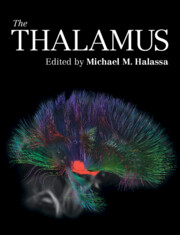Book contents
- The Thalamus
- The Thalamus
- Copyright page
- Contents
- Contributors
- Preface
- Section 1: History
- Section 2: Anatomy
- Section 3: Evolution
- Section 4: Development
- Section 5: Sensory Processing
- Section 6: Motor Control
- Section 7: Cognition
- Chapter 16 The Thalamus in Cognitive Control
- Chapter 17 The Thalamus in Attention
- Chapter 18 The Thalamus in Navigation
- Section 8: Arousal
- Section 9: Computation
- Index
- References
Chapter 17 - The Thalamus in Attention
from Section 7: - Cognition
Published online by Cambridge University Press: 12 August 2022
- The Thalamus
- The Thalamus
- Copyright page
- Contents
- Contributors
- Preface
- Section 1: History
- Section 2: Anatomy
- Section 3: Evolution
- Section 4: Development
- Section 5: Sensory Processing
- Section 6: Motor Control
- Section 7: Cognition
- Chapter 16 The Thalamus in Cognitive Control
- Chapter 17 The Thalamus in Attention
- Chapter 18 The Thalamus in Navigation
- Section 8: Arousal
- Section 9: Computation
- Index
- References
Summary
Selective attention is a cognitive process that enables the preferential routing of behaviorally relevant information through the brain.The associated large-scale network includes regions in all major lobes as well as subcortical structures such as the thalamus. There is mounting evidence that the visual thalamus–the lateral geniculate nucleus (LGN), thalamic reticular nucleus (TRN), and pulvinar–plays an important functional role in this process. The LGN has been traditionally viewed to be a relay of retinal information to the cortex. However, it has been shown that neural gain is amplified in LGN neurons, possibly in pathway-specific ways and via TRN-regulated inhibitory control, to amplify neural representations in the focus of attention at the expense of those that are unattended, thereby boosting attention-related information and filtering unwanted distracter information at the earliest possible processing stage of the visual pathway. The pulvinar is the largest nucleus of the primate thalamus and is almost exclusively interconnected with the cortex. Its function has remained elusive for many decades. Recent evidence suggests at least two functions that may be interdependent. First, pulvinar influences on the cortex are necessary to enable regular cortical function so that information can be processed from one area to the next. Second, the pulvinar coordinates information processing across the cortical attention network by synchronizing local population activity, thereby optimizing information transfer. Taken together, emerging views suggest roles for the LGN–TRN circuit as the gatekeeper and for the pulvinar as the timekeeper of the cortex.
Keywords
- Type
- Chapter
- Information
- The Thalamus , pp. 324 - 339Publisher: Cambridge University PressPrint publication year: 2022



